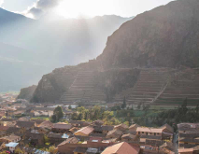Work is progressing on a new airport designed to bring more tourists to the Inca citadel Machu Picchu, a tourist attraction that is already straining under the number of visitors it gets.

In the nearby town of Chinchero, workers are preparing the landscape for a multibillion-dollar international airport that is already the target of a bidding war between companies from as far away as South Korea. The new airport would have larger runways that could accommodate direct flights from the U.S. and other nearby countries. At the moment, visitors to Machu Picchu fly into Cusco, which has one small runway, capable of accepting smaller planes from Lima and La Paz, Bolivia, after first flying to those cities.
Machu Picchu, a complex of ruins built by adventurous Inca several centuries ago and discovered only in 1911, now gets 1.5 million visitors every year; that total is nearly twice the annual number recommended by UNESCO, which administers World Heritage Sites. Only recently, UNESCO warned that Machu Picchu could be put on a list of endangered world heritage sites. Officials at Machu Picchu have worked to address this issue by limiting the time that visitors can stay at the site (6 a.m. to noon or noon to 5:30 p.m.) and decreasing the size of tour groups to 16.

Local officials, expressing concern that planes flying to the new airport would fly low over Ollantaytambo, another set of ruins, have delivered a petition to Peruvian President Martin Vizcarra urging the relocation of the airport. Another concern is the viability of the Cusco-area Lake Piuray watershed to continue to deliver enough water to the city to fill its needs.
At the same time, accompanying the beginning of construction of the airport have been other construction projects, of housing both temporary and permanent.